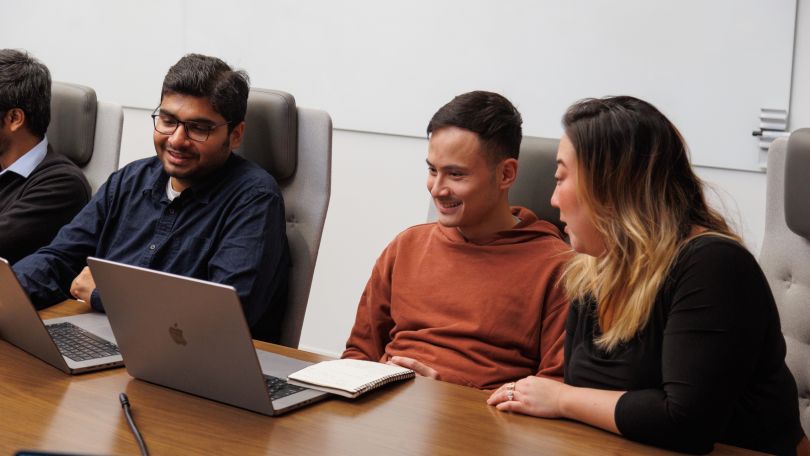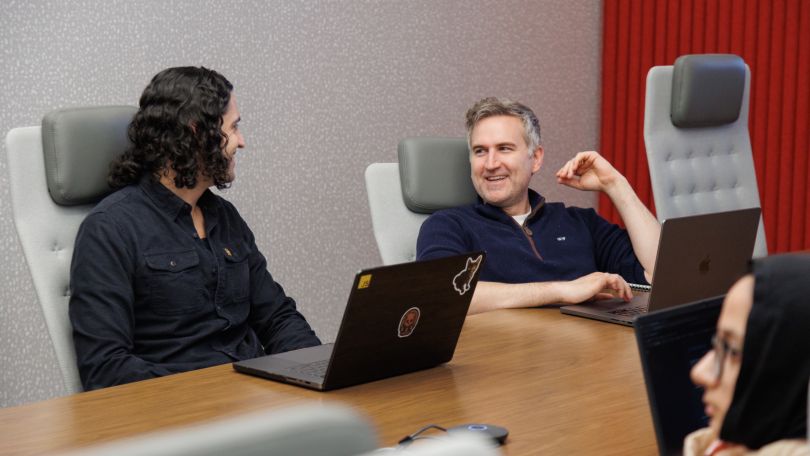AI may be the future, but the future of building great AI models all comes down to who is in the room and — more importantly — how they think.
For example, when Prosodica teammates are building AI models to analyze speech patterns, you might find a philosopher chatting through a problem with a machine learning engineer.
“At Prosodica, we’ve observed that blending cognitive styles actively influences our team’s thinking patterns,” Mariano Tan, CEO of Prosodica, said. “It’s causing people’s approaches to evolve as they naturally adopt mental habits and problem-solving strategies from their colleagues.”
What Does Prosodica Do?
Prosodica’s AI-powered platform automatically tags and scores customer calls to create data visualization and pinpoint areas of concern.
Tan theorizes that bringing a wide range of cognitive strengths into the same room — through generational and educational diversity — is the secret to future-proofing an organization. He refers to this as a “diversity in cognitive styles” and it’s exactly what he is trying to encourage at Prosodica.
“Cognitive style diversity describes the unique ways people approach problems and make decisions,” Tan said. “While not completely determined by it, these styles are significantly influenced by a person’s technological experiences and education.”
A software engineer trained in the ‘80s, for example, probably cut their teeth on early personal computers, limited information, and modeling solutions on paper, Tan said. Honing their problem-solving skills pre-internet, likely helped them develop their abstract thinking.
“Contrast this with someone who entered the workforce within the last decade,” Tan said. “They learned to quickly assemble and test solutions, leveraging extensive online resources and rapidly available examples.”
There are strengths to be found in both: Abstract thinkers can foresee hidden issues, while literal thinkers are often skilled at troubleshooting.
“Blending these styles creates powerful potential for innovation,” he said.
Read on for our full interview with Tan and to learn how exactly Prosidica is harnessing the power of diverse thinking styles — and what this might mean for the future of the growing company.
Mariano, diversity is a hot topic in workplaces today, but your focus seems a bit different. You’re emphasizing “diversity in cognitive styles.” What exactly does that mean?
Cognitive style diversity describes the unique ways people approach problems and make decisions. While not completely determined by it, these styles are significantly influenced by a person’s technological experiences and education. Jean Piaget first theorized about the developmental influence of experiences and interactions with the environment in the 1930s, and Marshall McLuhan later posited that the tools and media we interact with profoundly shape our ways of thinking. This influence can clearly be observed when examining how generational shifts in technology impact mental habits and problem-solving approaches. Not everyone from the same generation thinks identically, but recognizing and nurturing these cognitive differences can significantly enhance innovation, decision-making and organizational resilience.

Can you give an example of these generational cognitive styles?
Absolutely. Consider a software engineer trained in the 1980s. They developed their problem-solving skills pre-internet using mainframe or early personal computers. Information was scarce, computational iterations were slow, and with limited resources, they relied heavily on abstract thinking—often carefully modeling solutions on paper before coding. Contrast this with someone who entered the workforce within the last decade. They learned to quickly assemble and test solutions, leveraging extensive online resources and rapidly available examples. Abstract thinkers can foresee deeper, hidden issues, whereas literal thinkers excel at quick troubleshooting. Blending these styles creates powerful potential for innovation.
“Blending these styles creates powerful potential for innovation.”
Why is it critical to intentionally blend these different cognitive approaches in today’s workplace?
Today’s organizational challenges are rarely solved by a single way of thinking; they demand multiple perspectives. Abstract thinkers excel at framing complex issues, bringing depth and nuance to problems, while literal thinkers provide agility through rapid, practical solutions. Additionally, thinkers familiar with AI-driven methods add iterative and collaborative strengths. At Prosodica, we see the interplay of these cognitive styles in real-time as we pivot our core technology to incorporate more generative AI models. Our data scientists rapidly develop new models, but their agility is only possible due to the highly abstract and careful architectural work that enables our platform to seamlessly interact with diverse types of models. Combining these distinct cognitive strengths has made our organization much more resilient and adaptable.
Are advances in generative AI likely to promote yet another cognitive style?
Most definitely. Generative AI emphasizes iterative dialogue — where formulating the right questions becomes crucial, and solutions evolve through rapid cycles of evaluation and refinement. This cognitive style combines abstract conceptualization with iterative, practical assessments, significantly shifting how individuals approach problems. It also facilitates collaboration across cognitive styles and generations, enhancing team effectiveness and innovation.
You’ve challenged traditional views on diversity, arguing we should directly focus on perspectives rather than demographics. Can you elaborate?
I’m not trying to downplay the importance of traditional diversity initiatives, but rather emphasize how explicitly targeting cognitive diversity — differences in problem-solving approaches and thinking styles — can complement and even strengthen those traditional efforts. Interestingly, we’ve observed that actively seeking cognitive diversity has allowed us to naturally achieve broader diversity outcomes, since unique cognitive perspectives frequently correlate with varied backgrounds and life experiences. Of course, managing cognitive diversity isn’t always easy — it takes thoughtful effort and intentional leadership. But the benefits to organizational effectiveness, especially when tackling challenging problems, make that effort more than worthwhile. At Prosodica, we’ve also observed that blending cognitive styles actively influences our team’s thinking patterns, causing people’s approaches to evolve as they naturally adopt mental habits and problem-solving strategies from their colleagues.

Are different cognitive styles strictly a generational phenomenon, or can they also be influenced by other factors?
While generational differences certainly shape cognitive styles due to technological contexts, cognitive diversity isn’t strictly limited to age. Educational backgrounds significantly influence cognitive styles as well. For instance, someone educated in philosophy will naturally approach problems more abstractly, regardless of their age. Similarly, someone trained in engineering or computer science may adopt a more literal, iterative problem-solving style. Therefore, building cognitive diversity into a team doesn’t just mean hiring across generations — it also involves actively seeking team members with varied educational experiences and intellectual approaches.
What practical strategies can organizations use to foster this cognitive diversity?
Organizations should deliberately create cross-disciplinary and cross-generational teams, blending people who bring distinct cognitive strengths. For example, pairing philosophy graduates — trained extensively in abstract thinking — with practical problem-solvers from engineering or business creates robust cognitive partnerships. Companies should also integrate diverse cognitive exercises into professional development programs, such as scenario-based workshops that alternate between abstract reasoning tasks and rapid, iterative problem-solving. The goal isn’t to abandon technology but to thoughtfully integrate it, preserving essential human cognitive strengths.
What’s at stake if companies ignore cognitive diversity?
Organizations that neglect cognitive diversity risk intellectual homogeneity, diminishing adaptability, and becoming overly reliant on singular approaches to problem-solving. This could lead to missed innovation opportunities, stalled growth, or even failure to respond effectively to market changes. Conversely, organizations recognizing and strategically blending diverse cognitive styles position themselves for continuous innovation and effective adaptation to future challenges.







